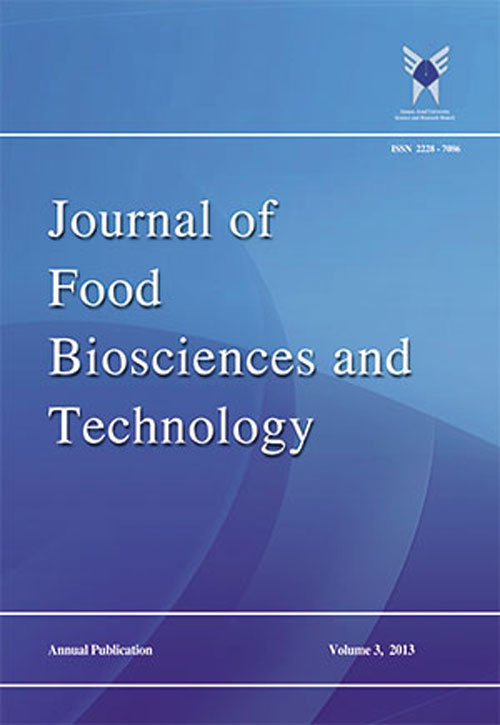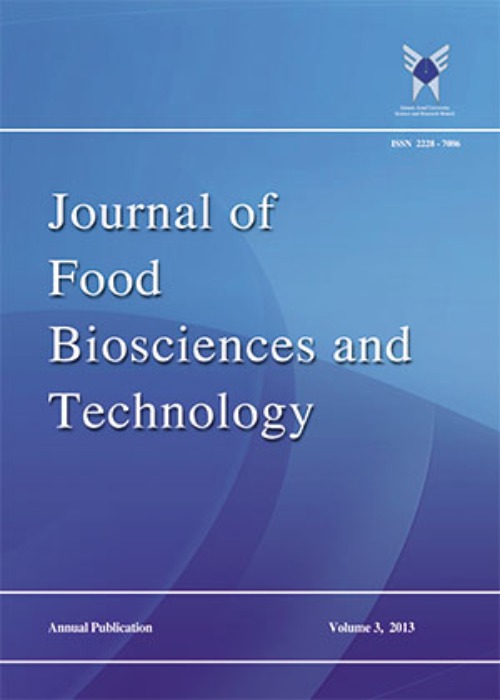فهرست مطالب

Journal of Food Biosciences and Technology
Volume:12 Issue: 3, Summer 2022
- تاریخ انتشار: 1401/02/19
- تعداد عناوین: 6
-
-
Pages 1-14
Yogurt whey contains lactose, lactic acid, soluble proteins, water-soluble vitamins, especially B vitamins, and minerals. Yogurt whey proteins can be a good source of bioactive peptides. In this study, we investigated the effect of enzyme type (pepsin and trypsin), temperature (37 and 50 °C) and time (120 and 240 min) of enzymatic hydrolysis on bioactive properties of protein hydrolysates prepared from yogurt whey. The results showed that increasing the enzymatic hydrolysis time from 120 to 240 min, increased the degree of hydrolysis, antioxidant activity (iron ion chelating activity, FRAP reducing activity and ABTS cation radical inhibitory activity) and antibacterial properties against various pathogenic bacteria (Escherichia coli, Staphylococcus aureus, Salmonella typhimurium and Listeria monocytogenes). Moreover, increasing the enzymatic hydrolysis temperature from 37 to 50 °C increased the degree of hydrolysis and decreased antioxidant activity and antibacterial property against Salmonella typhimurium. The antioxidant activity, antibacterial properties and hydrolysis degree of yogurt whey protein hydrolysates produced by trypsin were higher than those of pepsin. Two hydrolysates, were prepared with trypsin at 37 °C and pepsin at 50 °C for 240 min, were selected as the best samples in terms of bioactive properties.
Keywords: antibacterial properties, Antioxidant Activity, Enzymatic Hydrolysis, Protein Hydrolysates, Yogurt Whey -
Pages 15-26
Monascus is one of the fungi that can be used to produce red pigments with food grades. In this study, Monascus purpureus ATCC 16362 was used to produce red pigments in date waste substrates, using submerged fermentation. Response surface methodology was used to optimize three significant factors of date waste sugar concentration (20–60 g.l-1), NaCl (6–12 g.l-1) and initial pH (6–9). The, effects of independent variables on red pigment and biomass content were assessed. Concentrations of 20 g.l-1 date waste sugar and 6 g.l-1 NaCl and pH 9 resulted in the maximum yield of red pigments of 6.05±0.04 AU.ml-1 and biomass of 7.2 g.l-1. Furthermore, substrate conversion, yield of red Monascus pigments on biomass and the volumetric productivity included 82%, 10.42 AU pigment g-1 biomass and 5.36 g.l-1.day-1, respectively. Therefore, from the results of this study, date waste can be used as a low-cost substrate for the production of red pigments in large-scale studies.
Keywords: Date Waste, Munascus purpureus, Red Pigment, Response Surface Methodology -
Pages 27-38
Hydrocolloids, playing different roles including thickening, stabilizing, gelling and improving texture of foods are among additives widely used for improvement of quality in food industry. Recently, demand for hydrocolloids with special functional properties has grown, therefore, finding new sources of gums with proper attributes is of enormous importance. Therefore, this study aimed at investigating the effect of variables including temperature (30-80°C), concentration (5-9%) and shear rate (0.1-1000 s-1) on apparent viscosity and flow behavior of malva flower mucilage solution. The results showed that malva flower mucilage was rheologically pseudoplastic with this behavior being enhanced at higher concentrations (<n). The effect of temperature and concentration on flow index and consistency coefficient was also significant (p≤0.05). At low concentrations, power law model and at high concentrations, casson and bingham models best fitted with mucilage solution. Also mucilage solution at 5% and 9% concentrations showed the lowest and the highest temperature dependency, respectively.
Keywords: Apparent viscosity, Malva Flower, Mucilage, Rheology -
Pages 39-50
The bio-peptides additives use for multifunctional purposes of the dairy industry. Functional beverage investigated in this article based on milk and collagen peptides is by evaluation of organoleptic, physicochemical, and microbial properties. Hence confirmed the consumption of milk in the diet, that is a source of vitamins, minerals, and other biologically active substances and valuable nutrients in the prevention and treatment of bone as based are enriched, by collagen peptides with the effect on cartilage diseases, especially the treatment of Osteoarthritis. Sensory properties were evaluated in terms of taste and smell, chemical parameters such as total protein, pH, and texture stability. Experiments were designed to optimal peptide concentration in the range of 1.5 to 3.5% of collagen peptide during the 6-day shelf life of pasteurized milk. The results showed that the optimal concentration of 2.63% (w/v) from peptides to skim milk led to an increase in total protein from 3.022 to 5.77 g / 100 ml. Acidity, density, and Solid Non-Fat (SNF) increased compared to the control sample, while the pH decreased from 6.86 to 6.60. Besides increasing the total protein and nutritional properties of milk, regarding the sensory assessment, the concentrations of 2.63 and 2.86%, respectively had the most acceptable taste and closest flavoring to the control sample without any flavors contrarily source of the extracted peptide. Based on the microbial evaluation, the addition of the minimum concentration of peptide in milk resulted in a decrease in microbial load and an increase in shelf-life.
Keywords: Collagen Peptides, Fish Wastes, Functional Beverage, Fortified Milk, Shelf Life -
Pages 51-66
In this study pre-gelatinized corn starch was used in order to improve the sensory and physicochemical properties of low fat pizza cheese. Therefore, the effect of three independent variables including low fat milk powder (45-100%), fat (0-45%) and pregelatinized corn starch (0-10%) on physicochemical properties of low fat pizza cheese was evaluated using mixture statistical design by design expert software. Fifteen treatments were tested and according to the results the used statistical design was successfully applied for evaluation and optimization of the formulation of low fat pizza cheese. All physicochemical properties were significantly affected by the mixture components. As the results showed 67.56% low fat milk powder, 27.93% fat and 4.5% starch were the optimal quantities in the formulation. Melt ability, acidity, elasticity, firmness, total soil matters, flavor, texture and total acceptance were measured and indicated at highest acceptability among the treatments, 4.08, 0.46, 13.91, 14.11, 49.68, 3.85, 4.26 and 3.78 respectively. The closeness of estimated and measured values of responses for optimized formulation suggested the fitness of the selected models and their high predictability.
Keywords: Low-Fat, Pizza Cheese, Pre-Gelatinized Corn Starch -
Pages 67-77
Bread and other baked goods tend to undergo physicochemical changes after the baking process is completed. These changes are generally called staling. Authors have suggested a variety of methods for improving the technological and sensory properties of all sorts of bread, particularly voluminous and semi-voluminous breads. One of the most important one of these methods is the use of hydrocolloids in strategic products. This study analyzed the effect of different levels (0, 0.5 and 1%) of three hydrocolloids (pectin, carboxymethyl cellulose, and guar) on the rheology of dough and the quality of toast bread samples. The results revealed that changes in Farinograph attributes of dough depend on the chemical structure of the hydrocolloids. The largest effect belonged to the 1% guar, 1% pectin, and 1% CMC treatments. In general, hydrocolloids enhanced the dough samples. All hydrocolloids improved the qualitative properties of breads, delayed staleness, and provided better breads than the control sample. The largest effect was observed by the addition of 1% guar. According to the results, the opinions of the panelists, the treatment containing 1% guar was selected as the best additive as compared to the other two hydrocolloids.
Keywords: Carboxymethyl Cellulose, Farinograph, Guar, Pectin, Toast Bread


